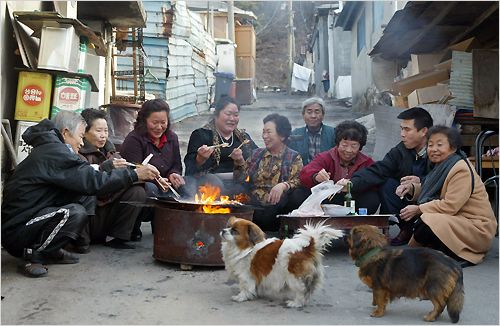(urban space) "Taltongne" report in Chosun Ilbo
Series of taltongne or poor hillside neighborhood reports in Chosun Ilbo around new year, made in Nowŏn-gu, Chunggye pon-dong . ▲ 눈 내린 중계본동 마을 전경(좌). 중계본동 야경./ 최순호기자 (Photo linked from Chosun Ilbo) "Hillside neighborhood, life can be happy despite difficulties"; reporter's postcript, written not in the neutral newspaper style but in the respective hapsyo spoken language style. Notice the idea that life can be humanely warm despite of dire economical and social circumstances; or rather the humanness and warmth of life is accentuated because of the poor circumstances. This can be compared to what the "priest" in Nan'gok in 2002 talked about living in the neighborhood: how it was poor and difficult but how one could feel the "human odor" (saram naemsae) or the odor of real life. Here's a picture of how the poor neighborhoods are often represented: places with good insim and lots of chông.  People grilling samgyôpsal meat in the alley (photo: Chosun Ilbo) Chosun Ilbo editorial on the same topic: seems that it's mostly about willingness of many (after the reports were published) to go out and offer their help as volunteers; that government poverty policy should concentrate on creating willingness to work (kûllo ûiyogûl k'iuda) and on creating more jobs but that it (the government) is not doing so. (뭐니뭐니 해도 국가가 가난을 물리치는 최상의 처방은 일자리 만들기다. 물가와 부동산값을 안정시키고, 공교육을 다시 세워 사교육비를 줄이는 것도 필수적이다.) Another excerpt from the editorial: 선진국처럼 빈곤 퇴치의 짐은 민간도 나눠 져야 한다. 부자건, 서민이건, 어둡고 낮은 곳을 따스히 껴안는 이웃들이 줄을 서고, 거기에 정치·경제적 리더십과 세심하고 실질적인 정부 정책이 바로 설 때, 가난은 더 이상 천형(天刑)일 수 없다. In the same series of articles: "Rice pasty maker with rice pastries, butcher shop keeper with meat". About volunteers bringing foodstuffs to the area welfare center (pokchi hoegwan) and preparing it there. [Notice the emphasis on volunteer work.] Categories at del.icio.us/hunjang: stratification • cities • neighborhood • Koreanculture |



Comments to note "(urban space) "Taltongne" report in Chosun Ilbo" (Comments to posts older than 14 days are moderated)
Write a Comment